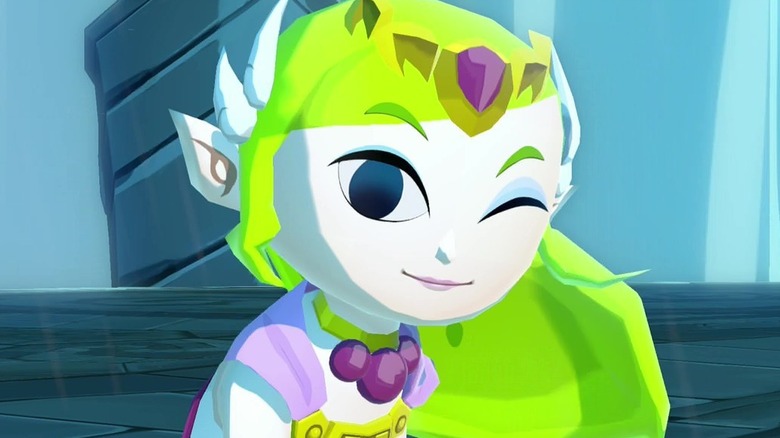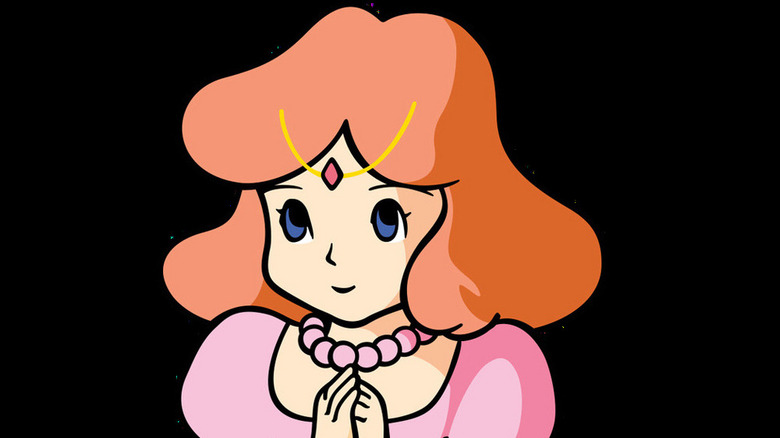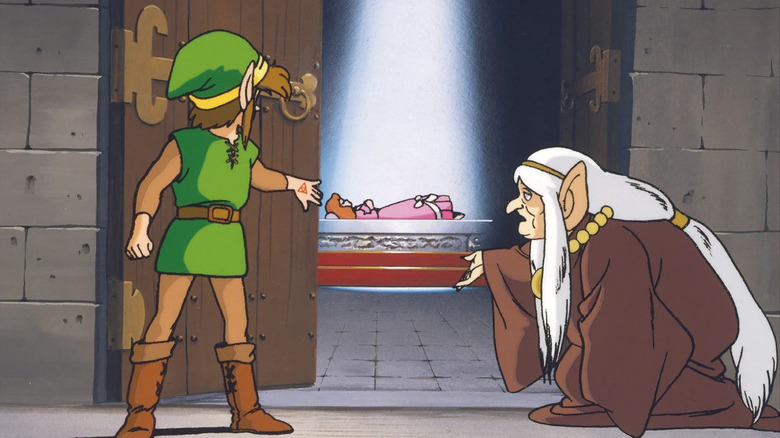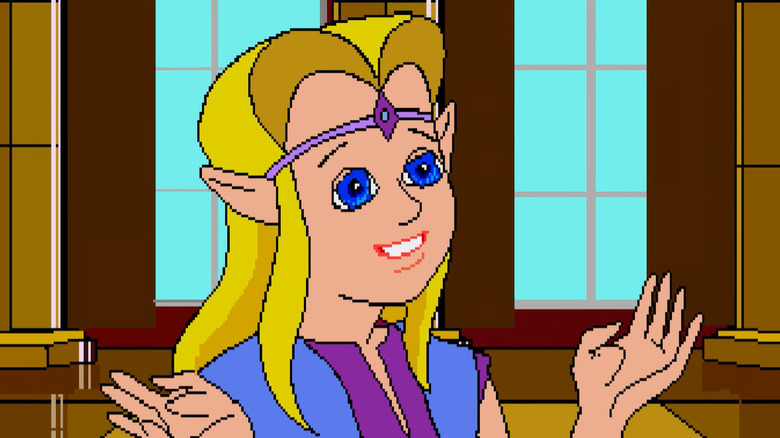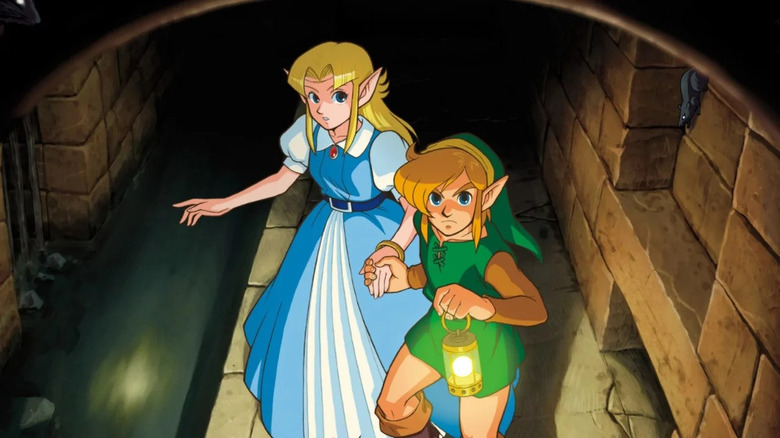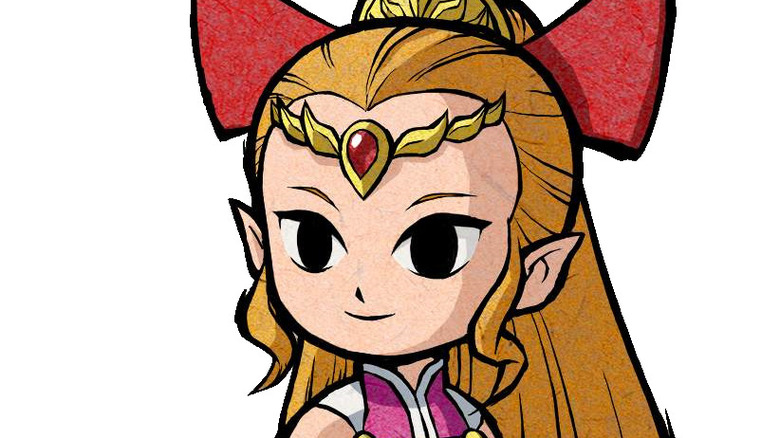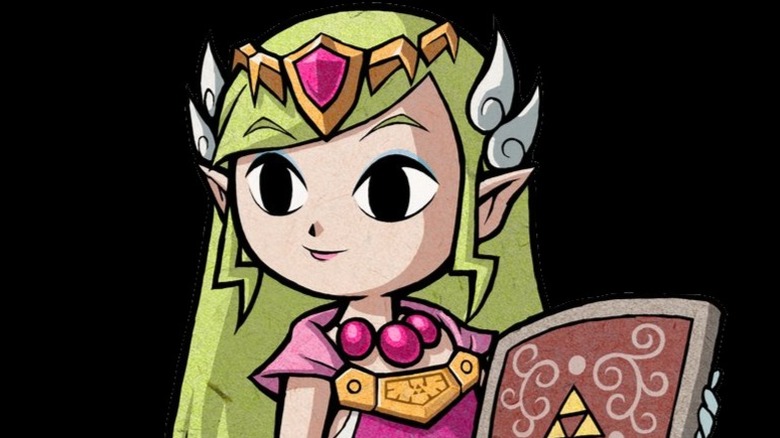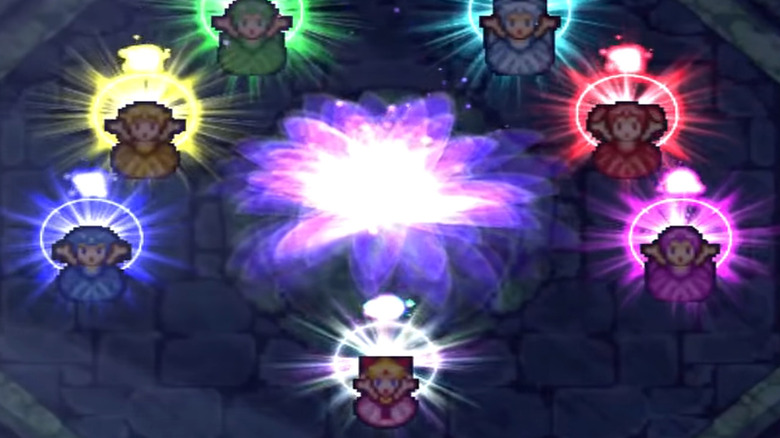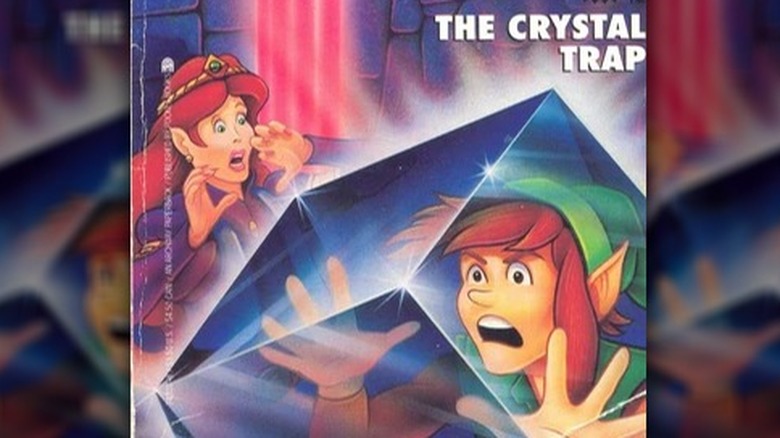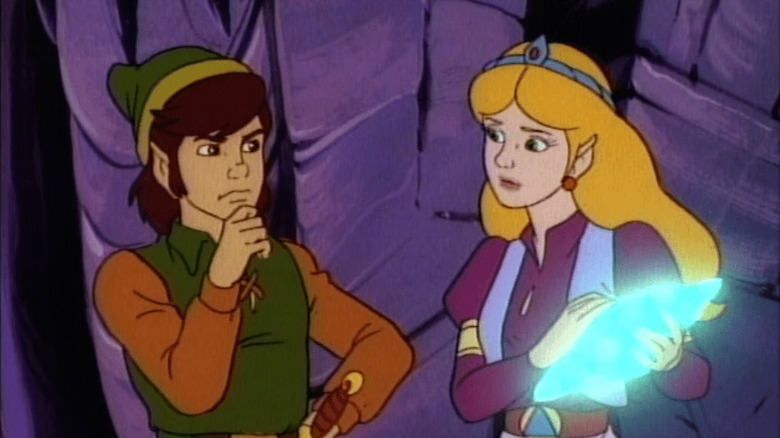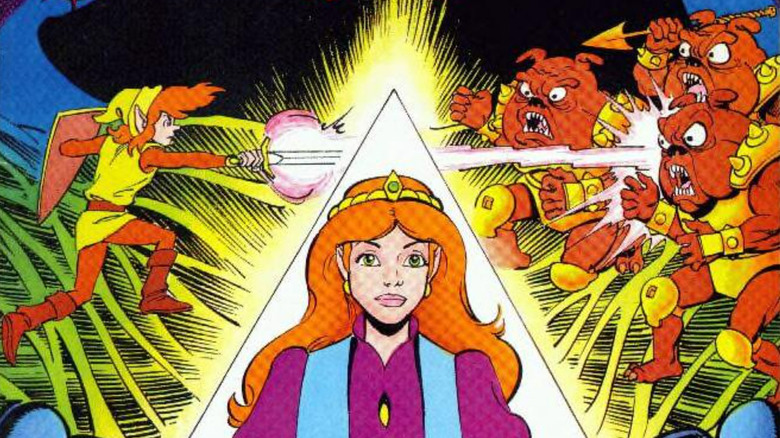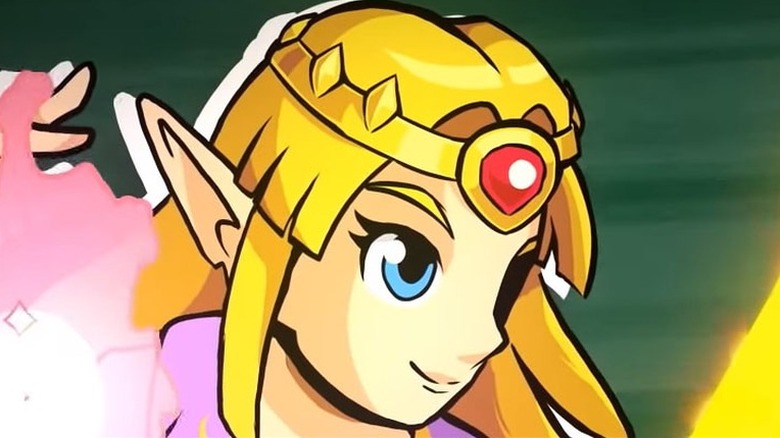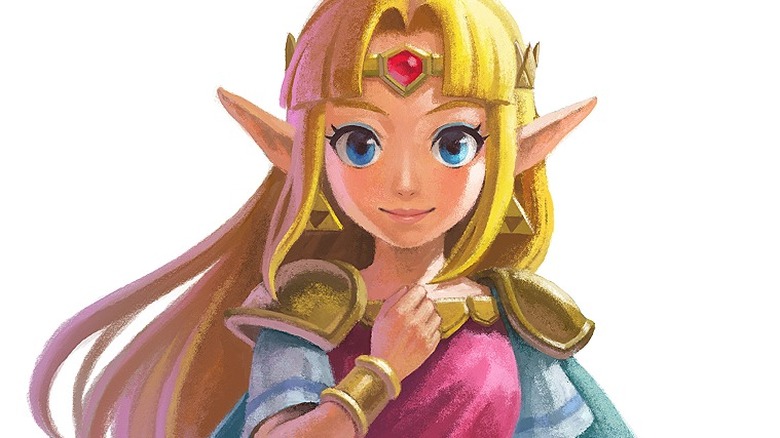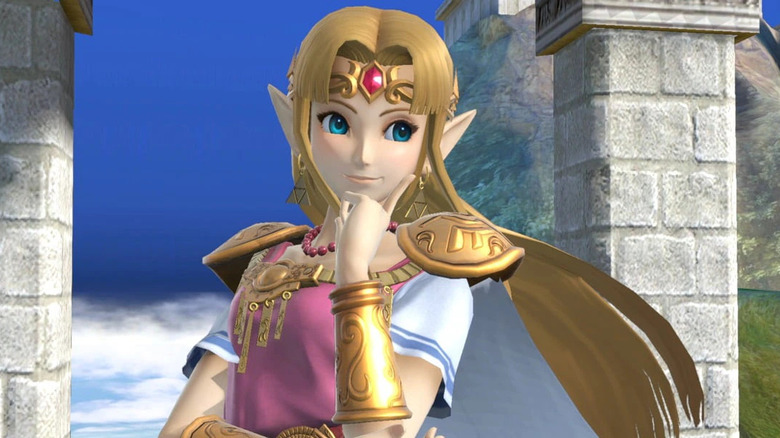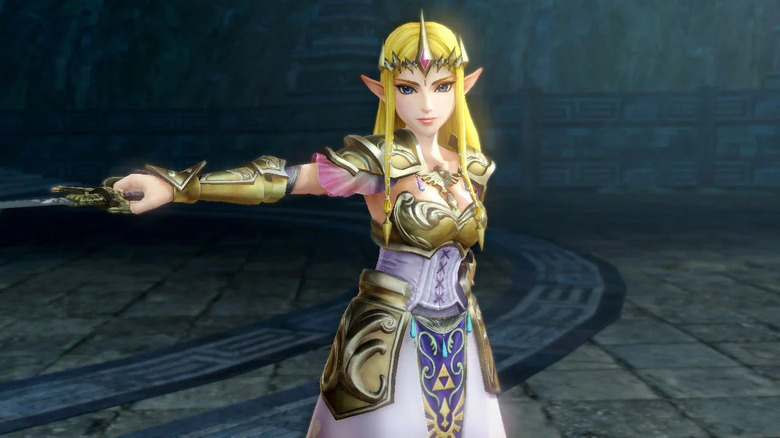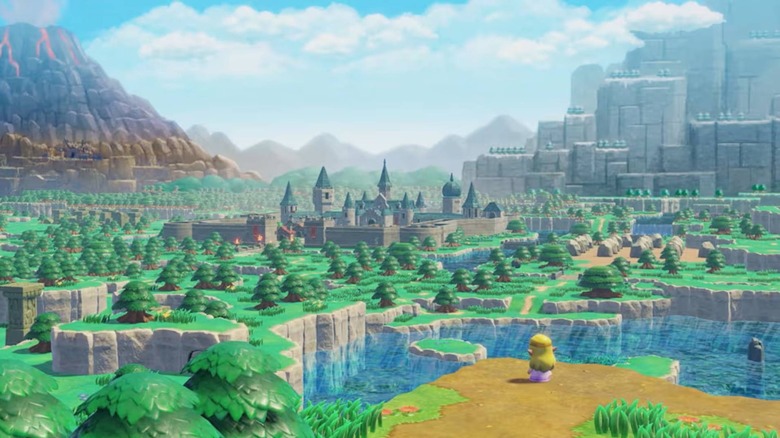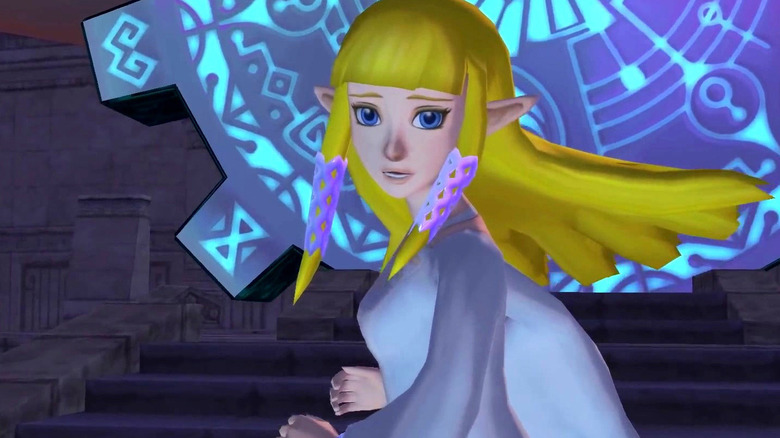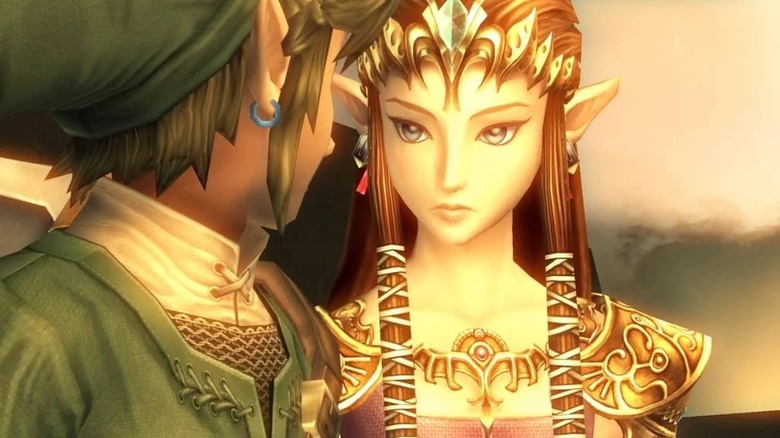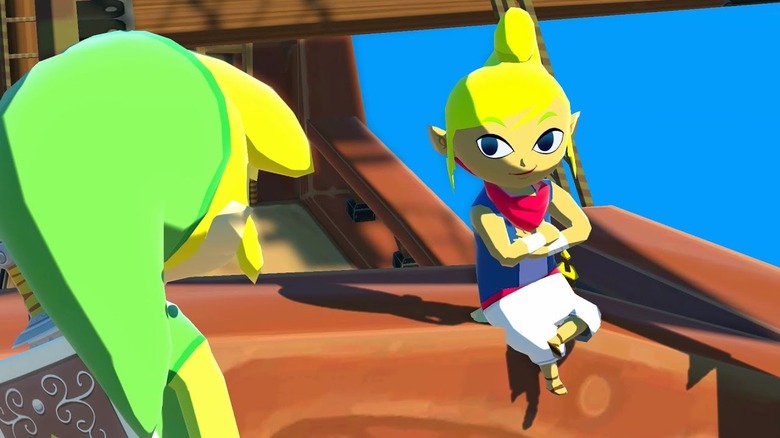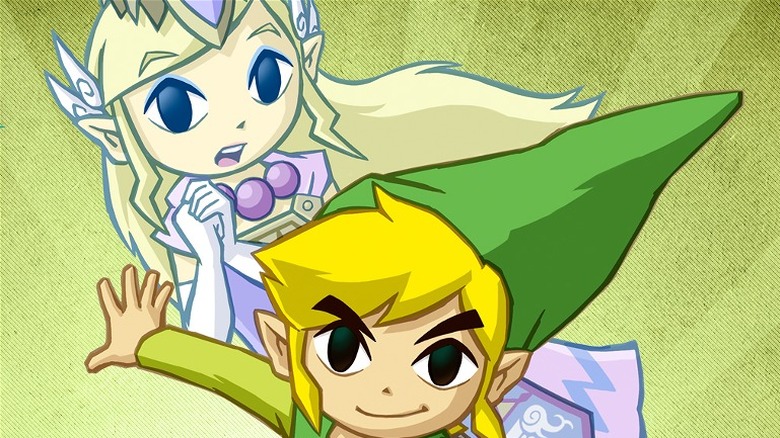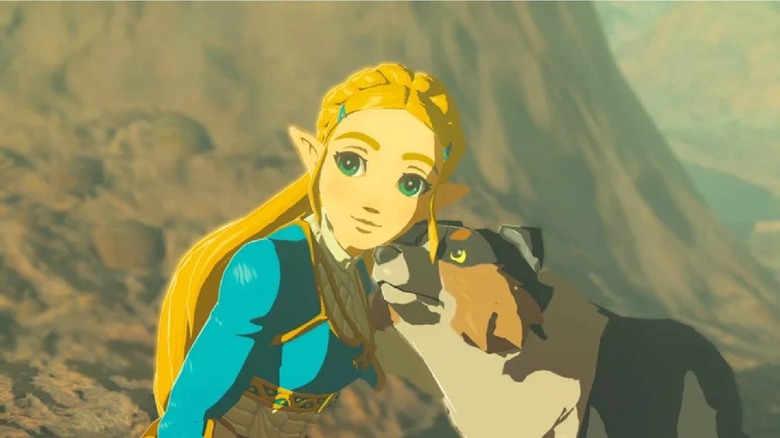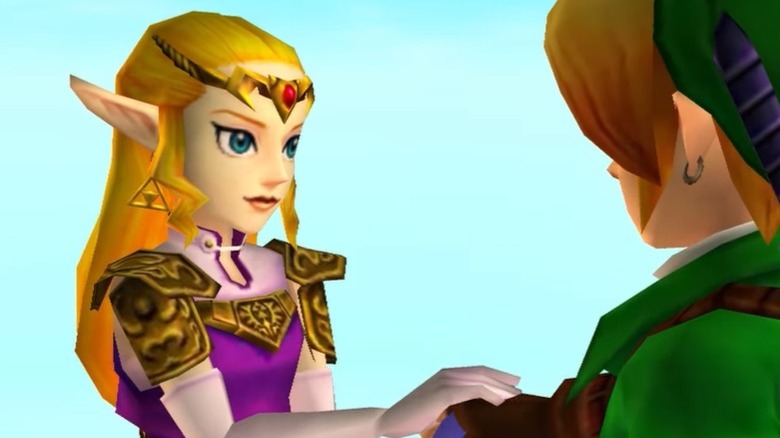Every Version Of Zelda Ranked
Nintendo has produced no shortage of iconic royals for its IPs. Of the regal lineup, Princess Zelda is perhaps the most recognizable, though the many iterations of Princess Peach have certainly given the Hylian a run for her money.
Before the first "The Legend of Zelda" entry hit the scene in the mid-1980s, series co-creator Shigeru Miyamoto set out to create an "eternal beauty" for his dashing new protagonist to rescue (per Hyrule Historia). When it came time to name his damsel, he turned to a famous real-world beauty for inspiration: the enigmatic writer and socialite Zelda Fitzgerald. Much like her namesake, Princess Zelda went on to become a style icon, influencing decades of artists, cosplayers, designers, developers, and fantasy writers.
Though well-known for her ethereal visage, Princess Zelda has become much more than just a pretty face over the course of dozens of mainline games and other media appearances. Prized for her wisdom and compassion, Zelda has demonstrated her dedication to the people of Hyrule again and again. Of course, not every version has done the character justice. Here's a look at Princess Zelda's best and worst moments throughout the franchise.
22. The original Zelda
Princess Zelda debuted in 1986 — alongside Link, Impa, and Ganon — in the game that started it all, "The Legend of Zelda." The NES title established many of the series' most well-known features, including what became one of the industry's most-quoted phrases: "It's dangerous to go alone! Take this." It also set into motion the long tradition of Zelda playing second fiddle to Link despite the fact that the franchise bears her name and not his.
Zelda gets kidnapped by Ganon before the action of "The Legend of Zelda" kicks off, leaving her with very little screen time. Though she succeeded in keeping the Triforce of Courage away from the Prince of Darkness, the plot centers on Link reassembling the fragments of the magical artifact she painstakingly hid away so he can go save the princess. Throughout this process, the kingdom of Hyrule remains at Ganon's mercy. Since Link needs the Triforce piece to defeat Ganon, it calls into question the wisdom of Zelda's decision to sunder it and distribute the pieces across eight labyrinthine dungeons in the first place. "The Legend of Zelda" remains an iconic game, but it is far from the princess' best outing.
21. The Adventure of Link Zelda
"The Adventure of Link" functions as a bit of an oddity for the "Zelda" series. Though it serves as a direct sequel to "The Legend of Zelda," "Zelda 2" favors a mixture of side-scrolling and top-down views along with RPG elements. It also utilizes a life feature that hasn't turned up in any other installment. The gameplay differences in the second entry may stand out, but its portrayal of Princess Zelda does not. The royal takes on the role of Sleeping Beauty thanks to a magical slumber, keeping her offscreen as Link fights his way through multiple palaces to claim the Triforce of Courage.
Adding a bit of intrigue, it turns out that this version is the original namesake of the princess from the first title. She's been snoozing for multiple generations due to a conflict with her brother and an overeager wizard. While she gets some points for standing up to her sibling to protect their father's secrets, the whole situation seems like it could have been avoided with better communication — a recurring theme for the franchise.
20. Philips CD-i Zelda
Many "Zelda" fans choose to ignore the trio of non-canon "Zelda" titles developed for the Philips CD-i, and with good reason. These bad boys have a lot of problems ranging from terrifying animation to bad level design and controls. But the second and third entries, "The Wand of Gamelon" and "Zelda's Adventure," stand out as the first games to make Zelda the playable character.
The Philips CD-i entries don't do Princess Zelda many favors, especially when it comes to her unflattering character designs, but she does at least get to play the hero. In "The Wand of Gamelon," she saves both Link and her father, the king of Hyrule, after neutralizing Ganon and a number of his minions. She rescues Link and takes on Ganon again on her own in "Zelda's Adventure." Though fans have long wished to see Zelda as a playable character, the Philips CD-i entries kind of make a mockery of that dream. It's quite unfortunate that they were the first to place the princess in a starring role, though at least they don't have a spot in the official "Zelda" lore.
19. A Link to the Past and Oracle Zelda
A Super NES masterpiece, "A Link to the Past" established even more of the classic components of the "Zelda" IP. Items like the Master Sword and Hookshot appeared for the first time in the entry, as did the concept of traveling between parallel worlds. Princess Zelda also plays a greater role in the plot than she did in the first two entries, though not by much. Keeping with tradition, Zelda winds up kidnapped at the hands of one of Ganon's servants, the wizard Agahnim. She summons Link to Hyrule Castle to help her out and they manage to escape Agahnim – at least for a time. Zelda then goes into hiding with a helpful priest while Link ventures forth to acquire Master Sword.
Zelda gets captured not once, but twice in "A Link to the Past," and the trend continues in "Oracle of Seasons" and "Oracle of Ages." The titles feature the same Zelda, who gets kidnapped by the antagonists Twinrova as part of their plot to resurrect Ganon. While she does receive more screen time, this Zelda unfortunately still functions as little more than a damsel and plot device to further Link's story.
18. Four Swords Zelda
Released on the Game Boy Advance, "Four Swords" took much of the "A Link to the Past" format and adapted it for multiplayer. Featuring two to four color-coded Links, the entry switches up the formula a bit to accommodate co-op play. For example, players compete to get the most rupees in each level and can only equip one item at once. Unfortunately, it does little to expand on Zelda's character.
"Fours Swords" sees Princess Zelda watching over the Four Sword Sanctuary and the artifact housed within, which serves as a prison for the sorcerer Vaati. Sensing that something is off, Zelda calls on her old friend, Link, to examine the shrine with her. Of course, the seal keeping Vaati trapped wanes, and he escapes, kidnapping Zelda in the process. Beyond her capture, it's yet another example of Zelda failing at her sworn task, prompting Link (or four Links in this case) to come in, save her, and clean up the mess. The princess just can't catch a break.
17. The Minish Cap Zelda
Another Game Boy Advance title, "The Minish Cap" centers on the origin story of the Four Sword and how Vaati ended up trapped inside of it. While it features a lot of classic "Zelda" elements, it also incorporates some new ideas, such as allowing Link to shrink down to a much smaller size with the aid of a sentient hat named Ezlo.
This time around, Zelda enjoys a bit of screentime before getting shelved. She and her pal Link go to a festival together and she even wins a prize during the outing: a shield that she gifts to her friend and protector. Of course, Vaati shows up and ruins the fun, though instead of kidnapping Zelda he transforms her into a stone statue. While a nice twist, this move still takes her out of commission for the bulk of the game. Link eventually saves the day, but it's a bit of a bummer that players don't get more time with this version of the princess.
16. Four Swords Adventures Zelda
A sequel to "Four Swords" created for the GameCube, "Four Swords Adventures" sends Link and his three duplicates on another quest. While the crew rightly suspects Vaati may escape his prison again, the story pits them against the dreaded Shadow Link, the hero's dark counterpart, as well. It also throws in Ganon as the mastermind behind the whole plot.
Zelda's role unfolds in a rather typical fashion at first, with Shadow Link kidnapping her and all six shrine maidens at the same time. After the Links save her, Zelda gets trapped again by Ganon (after she faces him alone, which is pretty badass if not particularly successful), though the protagonists quickly break her free. Thankfully, the princess then gets another moment to shine, assisting in the battle against Ganon by wielding magical balls of light. Because of this power and the aid of the other shrine maidens, the Links can finally seal Ganon within the Four Sword.
15. Choose-Your-Own-Adventure Zelda
Throughout 1991 and 1992, a dozen choose-your-own-adventure style novels hit the market as part of the "Nintendo Adventure Book" series. While most of the stories center on the "Mario" franchise, two feature the "Zelda" universe. The second, "The Shadow Prince," places Link in a variety of perilous situations. The first, "The Crystal Trap," puts Princess Zelda front and center. In a rare twist for the IP, Zelda must work through a number of dungeons and environments to save Link from a spell cast by Ganon. She has only 24 hours to break the spell, or he'll end up trapped inside a crystal forever. Readers get to decide which paths the princess follows on her quest, and she can acquire a number of items along the way, like a magic ring or magnifying glass.
"The Crystal Trap" has 14 potential endings, with most resulting in either Zelda or Link's demise. In the true ending, Zelda frees Link and they work together to defeat Ganon. While not the most groundbreaking portrayal of either character, it's nice to see Link playing the damsel and Zelda the hero for a change.
14. Cartoon Zelda
The "Zelda" franchise got its own animated series in 1989 as part of "The Super Mario Bros. Super Show!" While the show offers some nostalgia for fans through its incorporation of elements from the first two "Zelda" games, it didn't get the best reception, resulting in its cancellation after only 13 episodes. Nevertheless, it still has a few fun moments to offer. Much like the Phillips CD-i games, Zelda takes a more active role in the struggle against Ganon in the show, wielding a variety of weapons to aid Link in safeguarding the Triforce of Wisdom. Despite this, she still plays the damsel, with Link urging Zelda to kiss him pretty much nonstop (a plea she typically rebuffs). While a bit grating to watch again and again, this running gag led to a favorite catchphrase among certain gamers: "Well, excuuuuuse me, princess!"
Cartoon Zelda displays a strong personality and is not afraid to give Link, who often loafs around the castle, a piece of her mind. The two characters don't have the most attractive character designs, but at least they get to work together in a variety of whacky scenarios to foil Ganon's plots.
13. Comic book Zelda
Yes, there have been several manga based on the "Legend of Zelda" video games, but those largely follow the same characterization seen in their respective entries. For a comic that does something completely different, look no further than the early '90s run from Valiant Comics. The non-canon plot unfolds after the events of the first two "Zelda" games and follows the adventures of Link and Zelda as they work to prevent Ganon from getting his hands on the Triforce of Wisdom.
While the comics have a lot in common with "The Legend of Zelda" TV show, they offer a slightly more serious tone and a variety of problems to solve. Zelda once again gets to fight in different conflicts, even rescuing Link from time to time. The comics also mitigate some of the more annoying aspects of the TV series by making it plain that Zelda and Link share a reciprocated romantic connection. This lessens some of the ick factor of Link constantly trying to get the princess to kiss him. The pair don't often get to be in a relationship, further distinguishing their comic book portrayal.
12. Cadence of Hyrule Zelda
Though not part of the official timeline, "Cadence of Hyrule" blends the "Zelda" franchise with the rhythm-based "Crypt of the Necrodancer." The mechanics of both series come together to offer an enjoyable twist on the familiar, with Cadence getting pulled to the Kingdom of Hyrule to assist with a musical problem.
Rather than just focusing on Cadence, the title also follows Link or Princess Zelda as they take on the lute-strumming Octavo and his quartet of champions. Instead of getting kidnapped or sidelined, Zelda steps into the role of playable character for this outing, taking an active part in saving Hyrule. The royal wields both weapons and magic while facing off against a mix of new challenges and classic "Zelda" baddies in nostalgia-inducing scenarios. All and all, this Zelda functions as a refreshing take on a character who often gets left out in her own franchise. However, the game's relatively short runtime and place outside of "Zelda" canon tarnish the princess' luster just a bit.
11. A Link Between Worlds Zelda
Intended as a spiritual successor for "A Link to the Past," "A Link Between Worlds" honors the legacy of its predecessor. At the same time, it offers some unique mechanics, such as Yuga, the main villain, trapping Zelda and the Sages in paintings and Link's ability to merge with walls. Much like "A Link to the Past," the 3DS entry features parallel worlds, which take the form of Hyrule and Lorule, a kingdom that once had its own Triforce and has fallen into ruin following its destruction.
Despite retaining the title of princess, Zelda rules Hyrule alone – a situation that feels like it merits an upgrade to Queen Zelda. She does get captured by Yuga, the sinister sorcerer trying to resurrect Ganon (a plot that sounds all too familiar), but she contributes to the final conflict by providing Link with the Bow of Light. She and Link also show great kindness, using the wish granted by the reassembled Triforce to restore Lorule's own Triforce, saving the mirror kingdom despite the problems its inhabitants caused for Hyrule throughout the game.
10. Super Smash Bros. Zelda
Fans don't get many opportunities to play as Princess Zelda, which makes her inclusion as a fighter in the "Super Smash Bros." games particularly exciting. She debuted on the roster in "Melee" in the guise of adult Zelda from "Ocarina of Time." Packing in the nostalgia, her moveset consists of spells inspired by Nayru's Love, Din's Fire, and Farore's Wind. She can also transform into Sheik, upping the cool factor and setting her apart from other "Melee" characters.
In "Super Smash Bros. Brawl," Zelda appears as her "Twilight Princess" iteration. Though similar to her "Melee" counterpart, this version makes use of the potent Final Smash known as Light Arrow. Unfortunately, the excitement of getting to play as Princess Zelda is somewhat diminished by her low-tier rankings in both games. Her kit and playstyle leave her outranked by most of the other fighters, a sad fate for a character who doesn't even always get to shine in her own franchise.
9. Hyrule Warriors Zelda
Zelda has made several non-canon appearances over the years. Of these instances, her two "Hyrule Warriors" iterations stand out the most. The first "Hyrule Warriors" entry features different playable versions of Zelda, including Sheik from "Ocarina of Time," Tetra from "The Wind Waker," and a Princess Zelda that possesses powers, items, and weapons drawn from or inspired by multiple series entries. The latter combines magic and martial prowess as the leader of the Hyrulean Forces. Talk about a girl boss.
In the second "Hyrule Warriors" entry, "Age of Calamity," players step into the shoes of a host of characters to fight Calamity Ganon. Set a hundred years before the events of "Breath of the Wild," the hack-and-slash game features an alternate take on the same Princess Zelda. Drawing on her more scholarly inclinations, she can unleash a number of abilities using the Sheikah Slate. She also makes use of the Bow of Light and gets an adorable little Guardian companion named Terrako, further adding to her charm.
8. Echoes of Wisdom Zelda
Despite being the series' namesake, it took nearly 40 years before Zelda starred as the protagonist of her own mainline "Legend of Zelda" game. Luckily, this debut was well worth the wait, introducing the world to a fun twist to the "Legend of Zelda" series and a great interpretation of the beloved princess. Unlike other entries, "Echoes of Wisdom" decides it's Zelda's turn to rescue Link from the clutches of evil. Not only is this a welcome change of pace for a series that has predominantly focused on one character for so long, but the new Echoes ability is an excellent gameplay mechanic. Zelda can mimic objects and enemies to solve different puzzles and win each new battle.
On the downside, due to some of the limitations of the "Link's Awakening" remake style that "Echoes of Wisdom" follows, this version of Zelda isn't as fleshed-out as some of the others are. The cartoony presentation and minimal storytelling mean that "Legend of Zelda: Echoes of Wisdom" doesn't have much room for the character development fans would expect from more serious "Zelda" games like "Twilight Princess" or "Breath of the Wild." With that being said, the "Echoes of Wisdom" version of Zelda is still lightyears better than her first appearance as a protagonist in the aforementioned Philips CD-i game.
7. Skyward Sword Zelda
"The Legend of Zelda: Skyward Sword" includes a slightly different take on Link and Zelda, casting them as students of Skyloft's Knight Academy. This version of Zelda, the first in the official "Zelda" timeline, doesn't bear royal blood, though she does turn out to be the original mortal reincarnation of the goddess Hylia. While Zelda does get kidnapped in the first act, she subverts expectations by escaping the villain's plot and instead setting out to fulfill her destiny. In pursuit of this goal, she conducts multiple rituals, travels through time, and sacrifices her own freedom to ensure the destruction of Demise, one of the setting's greatest threats.
The bulk of her journey and struggles may not unfold on screen, but this Zelda accomplishes what she sets out to do and bears equal responsibility for saving the world she loves. "Skyward Sword" also depicts a romantic aspect of Link and Zelda's relationship that does not appear in most other "Zelda" properties. The pair seems to have a much stronger bond, making many of their interactions – even the simple moments in Skyloft – more satisfying. All and all, they feel like an evenly matched pair, making the "Skyward Sword" Zelda one of the most capable and memorable of the lot.
6. Twilight Princess Zelda
With the exception of "Majora's Mask," "Twilight Princess" represents the "Zelda" franchise at its darkest. The title kicks off with some child kidnappings and sees Link deprived of his Hylian body, forced to take the form of a wolf. Similarly, the people of Hyrule, caught in the perpetual Twilight unleashed by the sorcerer Zant, all transform into spirits. The Zelda of "Twilight Princess" cuts a regal and tragic figure. The sole ruler of Hyrule, she surrendered to Zant to prevent the destruction of her citizens, becoming a prisoner within her own castle. She wears dark clothing when she first meets with Link, a reminder of the somber circumstances they have all found themselves in. In other scenes she sheds the robes, revealing regalia befitting a monarch. This, along with the longsword she wields and other stylistic choices, combines to form Zelda's most elegant character design in the entire franchise.
It's clear that Zelda will pay any price to safeguard her subjects and those she cares about. She even sacrifices her physical form to save Midna, a princess from another realm. This allows Ganondorf to take control of her body, creating Puppet Zelda, a particularly noteworthy sub-boss. After Midna restores Zelda to her normal state, the Hyrule royal assists Link in the final showdown using the Light Arrows. Despite facing a number of tragedies and setbacks, the "Twilight Princess" Zelda never gives up, putting the strength of her spirit on display.
5. The Wind Waker and Phantom Hourglass Zelda
While the art style didn't please everyone, "The Wind Waker" introduced players to one of the most unforgettable takes on Princess Zelda: Tetra. Unaware of her royal heritage, Tetra has lived her life on the high seas as the captain of a pirate ship. Befitting her chosen career path, she sports pants, a curved blade, and unflappable confidence in her abilities.
Tetra doesn't escape the damsel in distress trope commonly used for Zelda, but she makes notable contributions throughout the game. Though other Zeldas followed suit, Tetra was the first iteration to join Link during the Ganon boss fight, during which she uses the Light Arrows. Even with the threat vanquished, she retains her sense of adventure, sailing off with Link in search of new places to explore.
Unfortunately, Nintendo disregarded what made Tetra so appealing in "The Wind Waker" for its sequel, "Phantom Hourglass." She disappears from the story almost immediately, with Link later discovering that she had been turned to stone. Stripped of all agency, she has nothing to do with resolving the title's central conflict, relying on Link to save her when she gets abducted by the antagonist (who captures her yet again after Link finally manages to return her to her normal form). All and all, it's a pretty disappointing final outing for a Zelda that showed so much promise in her debut game.
4. Spirit Tracks Zelda
Another sequel to "The Wind Waker," the Nintendo DS title "Spirit Tracks" takes place almost a century later. Due to the time skip, players meet new versions of both Link and Zelda. Unlike in "Phantom Hourglass," the princess takes a much more active role this time around. From the early moments, "Spirit Tracks" sets itself apart from other "Zelda" entries. Players actually get to play as Zelda during an escape sequence, and she remains a core part of the gameplay once Link steps back into the driver's seat. Though the antagonist steals the princess' body, she retains her spirit form. In this guise, she can possess Phantom Guardians, helping Link solve puzzles and move through different environments.
After returning to her body, the "Spirit Tracks" Zelda joins Link in the final battle, calling on her magic and Light Arrows. They can only take out the villain by working together. Given its princess is a direct descendant of Tetra who bears a strong resemblance to the pirate captain, "Spirit Tracks" even manages to partially make up for the missed opportunities of "Phantom Hourglass."
2. Breath of the Wild/Tears of the Kingdom Zelda
The "Breath of the Wild/Tears of the Kingdom" timeline brought us a masterfully developed take on Princess Zelda, who really steps up to defend her kingdom over the course of several centuries. Despite taking a backseat in the main story of "Breath of the Wild," a series of flashbacks introduce players to arguably the most complex and emotionally moving version of the princess. In this timeline, Zelda functioned as a powerful scholar and leader of Hyrule's Champions, who dedicates herself to unlocking the necessary sealing magic to stop Calamity Ganon. Though she eventually does access this power, she's devastated by the fact that it's far too late to save many lives, including those of the Champions and her father.
This nuanced depiction of the princess is further developed in "Tears of the Kingdom," where she is given a more integral role in the plot of the game. At the beginning of the game, Zelda is transported back in time to the founding of the Kingdom of Hyrule, where she witnesses the first sealing of Ganondorf. She shows even further depth when she sacrifices her human form to awaken a power to help defeat Ganondorf. This version of Zelda is incredibly compassionate and noble, to the point of losing herself in the process of saving her friends and subjects, making her one of the greatest and most memorable versions of the character.
1. Ocarina of Time Zelda
In addition to portraying Link as a top-tier hero, "Ocarina of Time" includes one of the most memorable Zeldas. Like Link, players first encounter a younger Princess of Destiny. Despite her age, she catches on to Ganondorf's less-than-altruistic motives, enabling her to set plans into motion that prevent a total loss when the Gerudo king takes over Hyrule Castle. Zelda then spends seven years in hiding, training for a rematch under the guise of the mysterious Sheik as she waits for Link to emerge from the Sacred Realm. Though she can't vanquish Ganondorf on her own, she assists the Hero of Time in awakening the other Sages, who she leads as the bearer of the Triforce of Wisdom. While the big bad does kidnap her towards the end of the narrative, she and the Sages play a key role in Ganondorf's defeat, which allows them to trap him in the Dark Realm.
Of all the versions of the princess, this Zelda has the greatest impact on the "Zelda" universe as a whole. Her decisions during the course of "Ocarina of Time" lead to the creation of three timelines: the Fallen Hero Timeline, the Child Timeline, and the Adult Timeline. Due to this far-reaching influence and her other qualities (Sheik for the win), she comes out on top in the Zelda rankings.

